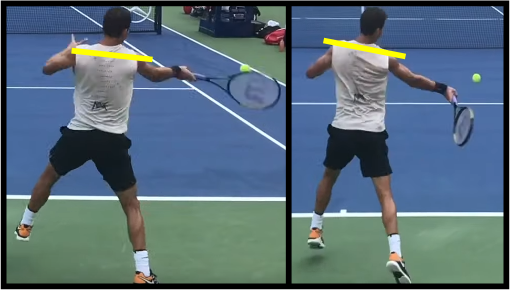Tour level players hit surprisingly high over the net. The amount of net clearance they’re getting is pretty difficult to see from the typical broadcast view: the bird’s eye camera, and as such, I think many club level players spend their entire tennis life aiming too low over the net, without ever realizing that they’re doing so.
In order to avoid net misses, you must aim higher over the net. I know that sounds trivial, but that is step 1.
Understand that you need to move your target higher.
The rest of this article will be about how to do that while making minimal sacrifices elsewhere.
Rotational Power Transposition

Big words, I know, but let me explain.
Our goal on the forehand is to use the large muscles of the legs, hips, and trunk to accelerate the racket. In order to do so, we rotate into our shot, and that rotation powers the stroke.
We can transpose this rotation to create spinier shots, or flatter shots, by tilting our torso, or leveling it out.
With a level torso, our core rotation will generate a racket path that is almost completely back-to-front, with very little low-to-high trajectory at all. What little low-to-high trajectory we have will be from allowing gravity to pull the hand down slightly, and then having the hand flick back up, but none of it will come from the primary rotational engine of the stroke.

When we tilt our shoulders, that same stroke, which used to be entirely back-to-front, now has a vertical component, and the more we tilt our shoulders, the more vertical that swing becomes.
The shoulder tilt is our primary tool for altering the spin/flat nature of our shots, while still harnessing the same fundamental kinetic chain to power the swing.
Some of the fundamentals manifest slightly differently with a tilted torso – the player’s weight tends to be less over their back foot, and the swing is more punishing of a tight wrist – but the first principles of a loose wrist, explosive rotation, and out-and-in-front contact point are the same.
You Almost Always Tilt

We’ve dedicated two articles to low forehands specifically: one about this same shoulder tilt concept, and the other about applying these concepts to dominate opponents who slice.
While shoulder tilt is crucial for effective, heavy, low forehands, it’s also essential for waist height forehands, and even chest height forehands.
Yes, even when the ball bounces up to your chest, most of the time you’ll still want a slight shoulder tilt as you rotate, in order to add verticality to your swing path. That added margin over the net is crucial for playing high-margin offensive tennis.
After you get the hang of tilting, you’ll realize just how high over the net it’s possible to hit while still driving through your shot.
Many Players Have Never Considered Tilting
If a recreational player doesn’t realize just how high over the net elite players are hitting, even while playing offense, then they won’t recognize that there’s anything amiss when their own offensive shots routinely pass only 1 foot (30 cm) over the net, rather than 2-3 feet (60-91 cm).
When they miss into the net, then, they assume it’s because they’re simply not good enough, never considering that perhaps they’re aiming to a bad target. The solution is to employ varying degrees of shoulder tilt on almost every forehand below the shoulder level, even when playing offense.

Varying Your Tilt
Almost all forehand situations call for some degree of tilt, but how much it calls for is up to you. As we’ve discussed before, low balls call for a lot of tilt. Chest height, aggressive balls call for less.

On defensive shots, you might actually require less tilt, because you’re not rotating as explosively and so you you don’t need as much spin to keep the ball in. The beauty of the shoulder tilt is that it doesn’t fundamentally change the swing, so you don’t need to practice each kind of forehand as it’s own, isolated unit.
Instead, just internalize shoulder tilt as one degree of freedom, among many, that you have at your disposal while playing the forehand. You can dial it up and down as needed. This is a vastly superior mental model of how to create height over the net than one of yelling “get it up” at yourself, and then ripping up with your hand and arm through contact (though adding a little upward volitional arm movement along with the tilt is fine).
Next time you’re out on the court, see if you can integrate shoulder tilt into your shot. Once it begins to feel natural, you’ll gain a control over your net misses that previously seemed impossible.





April 18, 2024
Why not just bend your knees to get more verticality?
April 19, 2024
Good question, and it gets at a common misconception. Bending your knees does get you lower to the ground, and that is necessary on low balls, so you certainly will bend your knees, but what it doesn’t do is change the plane of rotation of your swing path. In order to have your comfortable forehand (or backhand) stroke naturally travel in a more low-to-high plane than usual, you have to tilt your torso. If you just bend your knees, but you don’t tilt your torso, you won’t be able to swing with velocity on a low ball.
November 7, 2024
Exactly the problem I have, my shoulders are never tilted! Is there a way to practice this? Is there something I can focus on so the tilt of the shoulders happens automatically?
Please help me, I would really really appreciate it!
November 11, 2024
Good question. My favorite tool for building this into habit is the medicine ball. On court, focus on twisting both down and back – you want a bend at the hips during your preparation, and that’ll naturally encourage the shoulder slant as you twist into the ball.